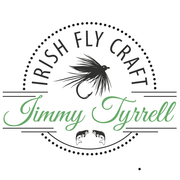Tyrrell's The Cock Robin - Irish Angler Magazine November 2013
- by Irish Fly Craft Admin
-

The Cock Robin is a true Irish pattern, one that has stood the test of time and is still a very popular pattern today for a lot of lough anglers. Jimmy Tyrrell recounts its history.
This is another of the bronze mallard winged patterns that is of Irish origin. It’s an old pattern that originates from Co Clare. Like a lot of the old patterns I like to look back at their origins and any information as to how they were used and what they imitated.
This is a relatively young pattern compared to a lot of the old flies. The fly was devised in the 1890s by the Egan brothers for fishing Lough Inchiquin. It’s still an outstanding fly and one that is used quite a lot and is a versatile pattern as it can be used for both river and lough, a fly that is known throughout the shores of Ireland and beyond.
The Cock Robin is a mid-summer to autumn fly. It can be fished throughout the day, but would probably be best used in the late evenings. This is a fly that I would tie quite a lot of anglers on the loughs every year. It’s a pattern that has spawned a lot of variants – as do a lot of the good patterns – from dabblers to blue winged, but the body colours always stays the same and the original is still the most popular fly of all of them in my opinion.The fly is a great attractor with its jointed body of yellow and red, suggesting a cock robin with its red breast.

The fly is associated with the book An Angler’s Paradise by HD Barker. This is one of the best true life books on fishing that I have ever read. It tells of one man’s fishing adventures spanning over 20 years on the loughs and rivers of Co Clare where he spent his holidays every year with his long time friend and boatman Patsey Egan.
Barker, having made a pile in the City of London, decided to do a spot of fishing in Ireland and ended up going to the same place at least twice a year for the next 20 years. He concentrated on pike and trout, but he seems to have caught more of less everything and could hardly have chosen a more alluring title. The interesting thing is that he did his best to conceal where the fishing was, as none of the places he fished are named in the book. If you’ve never read it I’d recommend it highly as it is a classic read. I have read it a number of times and still go back to it.
I came across a selection of some of the original patterns that were tied by Frank Egan, who was one of the ghillies in the book. These flies were all tied in the hand with no vice. These patterns are all done with dyed pig’s wool in the bodies.
Below is an excerpt from a letter, which was written by the original owner of the book and was inside it along with the flies when it was bought by a good friend of mine who kindly let me see them and allowed me to show them, for which I am eternally grateful. Things like these are unique and you don’t see them too often and it is a bit of Irish fly fishing and fly tying history.
This book is about Corofin, Co Clare
"I knew Frank well. Patsey was dead when I first came there. In the book his ghillie Patsey and his brother frank were Egans. Frank was a master fly tyer and these flies are ones that he tied for me. I left them as examples of his work, The famous Cock Robin is one of them. The body material is pig’s wool. I often saw him at work and he never used a vice."
After all those years I am glad that I am able to show these flies that were tied in the hand as I am sure the gentleman that wrote the letter would be happy that the memory of these things lives on. The pattern today is tied more or less the same now as it was back then. The only difference now is the body material, which is now seal’s fur.
The Cock Robin
| Hook: | Partridge medium wet size 10 or 12 |
| Tail: | Fibres of bronze mallard |
| Rib: | Oval gold tinsel |
| Body: | First half golden olive seal's, second half red or scarlet seal's fur |
| Hackle: | Red game feather fibres |
| Wing: | Bronze mallard |





